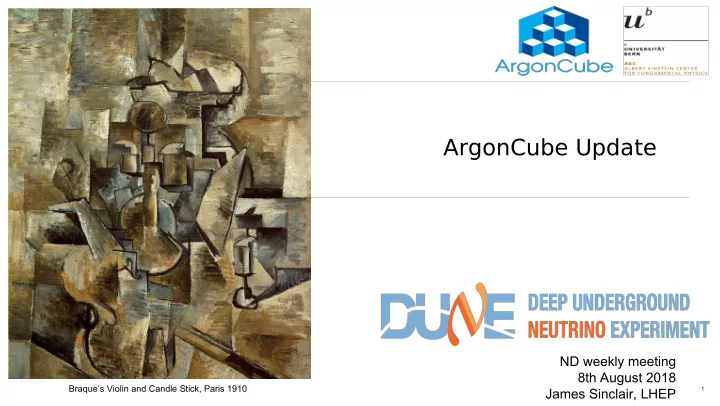

ArgonCube Update ND weekly meeting 8th August 2018 Braque’s Violin and Candle Stick, Paris 1910 1 James Sinclair, LHEP
ArgonCube 2 Cut-away illustration of an ArgonCube module, and an array of modules in a common cryostat (N.B. Modules will be sealed.)
The 4x5 geometry optimised for the DUNE ND. In the FNAL low-density cryostat with beam window. Instrumented modules sharing common cryostat (initially filled from and cooled by). Service volumes housing cryocoolers and recirculation pumps (move cold LAr through heat exchanger at base of modules) 3
Module Requirements Transparent to tracks: LAr – Radiation length = 14.0 cm – Hadronic interaction length 83.7 cm G10 structure – Radiation length = 19.4 cm – Hadronic interaction length 53.1 cm. Minimise all material in surrounding active volume. Light readout: Compact (thin), dielectric, and large area coverage Charge readout: Compact, mechanically robust, and unambiguous 4 Cut-away illustration of an ArgonCube module
Module Component Pump and filter no longer required “on-module”. Clean 0.4 m LAr supplied by external lines – less dead material. Clean LAr circulated through heat exchange, extracted above cathode and readout electronics. Charge readout: 2 x 3 m 2 pixel planes, 3 mm pixel pitch, 6.6x10 5 pixels 3.0 m per module. Signals digitized by LArPix ASICs mounted on rear of pixel PCB. Cooled by LAr flow. Light readout: ArCLight (arXiv:1711.11409), dielectric tiles supporting and lining the inside of the field-shell. m 1 . 0 Field-shell… most of what I’ll be talking about today 5 1 . 0 m
Why a Field-Shell? Why move from a field cage to a field-shell? Physics: Minimize dead material and maximize active volume. Reliability: Reduce component count and therefore points of failure. Limit power release in the case of breakdown. 6
Suitable Material Provide continuous linear potential distribution along the drift direction. Uniform resistance O 10 GΩ/□ at desired voltage and temperature; -50 kV and 87 K. Field-shell can be produced with resistive sheet in the form O 100 μm foil, or as a O 10 μm laminate on a G10 substrate (module walls). 50 μm sample of Carbon loaded Kapton had resistance of 16 GΩ/□ at 77 K (at 0 V). Resistive Kapton test sample in Bern, April 2018 7
Field-Shell Test TPC 15 cm drift length. 7 x 7 cm 2 cathode & anode. E-field range 0 kV/cm → 1.5 kV/cm. Kapton charge readout and pre-amps Perforated Kapton field shell 15 cm PAI support structure Kapton cathode Electrostatic shielding 7 cm Trigger: Muon telescope (foil wrapped scintillator tiles instrumented with SiPMs) 8
A Note on Charge Readout This is to test the field-shell not the readout. 7 cm Leftovers from early prototypes… 2-plane wire readout printed on 50 μm Kapton. 64 channel: 32 induction, 32 collection. Combination of BNL LARASIC4* and LARASIC7. ...No pixels – no nice 3D event displays, sorry. 9
Results So Far Triggering on only crossing muons produces a data set of clean tracks. Straight tracks observed across a range of E-fields. Field uniformity will be studied further by comparing with the expected distribution of tracks for the telescope geometry. Cosmic muon crossing resistive shell TPC at 1.0kV/cm, July 2018 10
Expected Track Distribution Assuming a cosine distribution, the expected distribution of crossing tracks triggering the muon telescope is: (from above) (from side) 11
Expected Track Distribution Efficiency of muon telescope as function of position still needs to be determined, this will alter the expected distribution. (more efficient closer to SiPMs) Measurement under way. ArCLight tile photon detetection effeincy 12
Electrical Properties of the Field-Shell From voltage and current measured at the high voltage power supply. Non linear I-V relation ship observed. 13
Electrical Properties of the Field-Shell Almost 1 W dissipated into the LAr. Unlike a field cage this is not localized to resistors, but spread across the 0.04 m 2 area of the field-shell. No boiling was observed. 14
Electrical Properties of the Field-Shell Variation of resistance with voltage could explain the difference between the CERN measurement of the Kapton cathode. The resistance remains in a usable range O 10 GΩ/□. It should be determined if this is area dependent – larger samples needed. Limited by resolution of power supply 15
Field-Shell Summary A field-shell formed of resistive Kapton foil looks like a viable option for field shaping in ArgonCube, and future LArTPCs. The field uniformity is still to be determined, and the electrical properties as a function of area. These measurement will require a larger sample. In order to secure larger quantities, issues with the supplier need to be addressed. 16
Recommend
More recommend